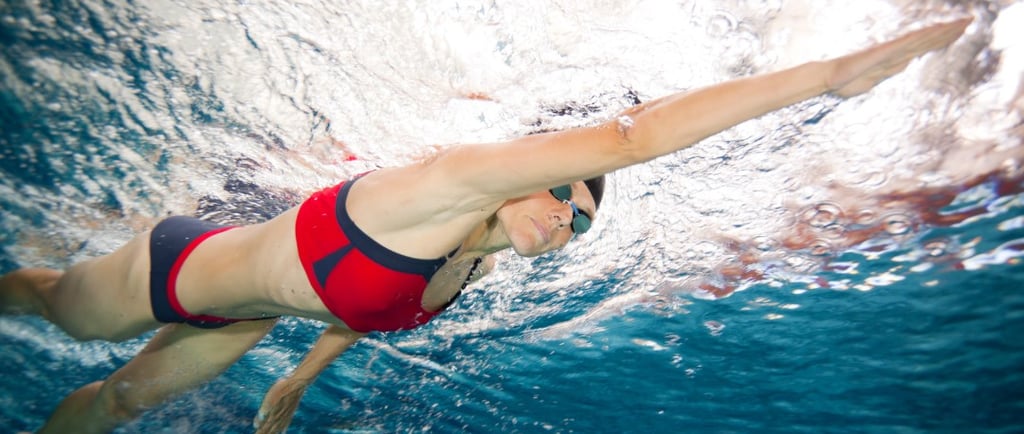Does Swimming Really Train Your Whole Body? How to Maximise the Benefits
Discover which muscles swimming works in freestyle, backstroke, breaststroke, and butterfly, and why mixing strokes gives a full-body workout.
FITNESS
9/20/20252 min read


Does Swimming Really Train Your Whole Body?
Swimming is often described as a full-body workout. It gets your heart pumping, improves circulation, builds stamina, and increases lung capacity. At the same time, it is gentle on the joints, while still strengthening your muscles, since water provides 12–14 times more resistance than air. The stretching motions of each stroke also enhance flexibility, helping you stay agile. Plus, the rhythmic movements of swimming can lower stress and calm the mind.
There’s no doubt that swimming is good for you. However, you may notice that each stroke uses different muscle groups, and if you only stick to one style, it might not truly count as a full-body workout.
Let’s explore which muscles are engaged by each swimming stroke, and how you can use a variety of styles for a balanced full-body workout.
Muscles Worked in Swimming: Stroke by Stroke
1. Freestyle (Front Crawl)
Freestyle is the fastest and most common stroke, but it’s also one of the best for overall conditioning.
Upper body: Shoulders (deltoids), upper back (latissimus dorsi), and arms (biceps and triceps) drive the pulling motion.
Core: Abdominal and oblique muscles keep your body stable and streamlined.
Lower body: Glutes and quadriceps power the flutter kick.
Freestyle is great for building endurance while working both upper and lower body in balance.
2. Backstroke
Backstroke is essentially freestyle flipped over, but it targets slightly different areas.
Upper body: Shoulders, lats, and upper back muscles are heavily engaged with each pull.
Core: The lower back and abs are used to keep the body aligned on the surface.
Lower body: Hamstrings and glutes are activated with the continuous flutter kick.
Because you are facing upward, backstroke is easier on the neck and can help improve posture by strengthening the back muscles.
3. Breaststroke
Breaststroke is slower and more technical but still highly effective.
Upper body: Chest, triceps, and shoulders are used during the outward sweep and push of the arms.
Core: Core muscles stabilise the torso and help coordinate timing.
Lower body: Inner thighs (adductors), glutes, hamstrings, and calves all work hard during the frog-like kick.
Breaststroke is excellent for flexibility in the hips and chest, and it strongly targets muscles in the legs compared to other strokes.
4. Butterfly
Butterfly is the most challenging stroke, but also the most powerful.
Upper body: Chest (pectorals), shoulders, and arms generate strong pulling movements.
Core: The abdominals and obliques drive the undulating dolphin-like body wave.
Lower body: Quads, glutes, and calves engage during the dolphin kick.
Butterfly demands a lot of energy but delivers a full-body workout, especially for the chest and core.
Maximise the Benefits by Mixing Strokes for a Full-body Workout
As you can see, each swimming style emphasises different muscle groups. Freestyle and backstroke are fantastic for building endurance, butterfly develops raw power and core strength, while breaststroke focuses on the legs and chest.
For most swimmers, a combination of freestyle, backstroke, and breaststroke can effectively work all the major muscle groups. Since butterfly is the most technically demanding stroke, you can treat it as an optional challenge, perfect if you are more experienced or want to add extra intensity and core/chest engagement.
Conclusion
Each swimming style targets different muscles, and by combining freestyle, backstroke, and breaststroke in your sessions, you can achieve a well-rounded, full-body workout.
For most people, 30–45 minutes of mixed-stroke swimming is enough to build endurance, strengthen muscles, and relieve stress. On top of that, swimming is joint-friendly, burns calories efficiently, and supports both physical and mental wellbeing.
If you have access to a pool, swimming is an excellent option to include in your fitness routine!
Sakura Fitness & Beauty
Promoting fitness, health, wellness, and beauty.
© 2025. All rights reserved.
London, UK
info@sakurafitnessbeauty.com
